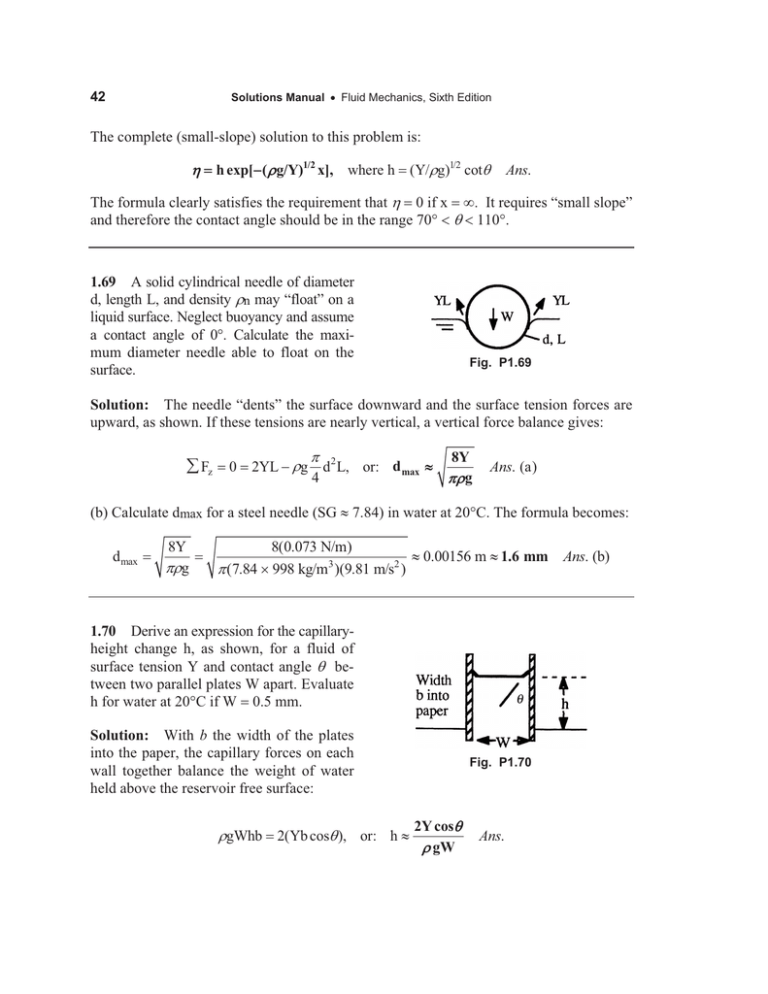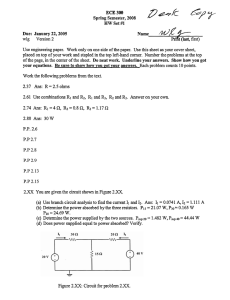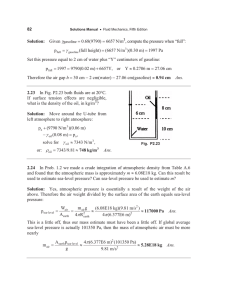K
advertisement

42 Solutions Manual x Fluid Mechanics, Sixth Edition The complete (small-slope) solution to this problem is: K h exp[ (U g/Y)1/2 x], where h (Y/Ug)1/2 cotT Ans. The formula clearly satisfies the requirement that K 0 if x f. It requires “small slope” and therefore the contact angle should be in the range 70q T 110q. 1.69 A solid cylindrical needle of diameter d, length L, and density Un may “float” on a liquid surface. Neglect buoyancy and assume a contact angle of 0q. Calculate the maximum diameter needle able to float on the surface. Fig. P1.69 Solution: The needle “dents” the surface downward and the surface tension forces are upward, as shown. If these tensions are nearly vertical, a vertical force balance gives: S ¦ Fz 0 2YL Ug d2 L, or: d max | 4 8Y SUg Ans. (a ) (b) Calculate dmax for a steel needle (SG | 7.84) in water at 20qC. The formula becomes: d max 8Y SUg 8(0.073 N/m) | 0.00156 m | 1.6 mm Ans. (b) S (7.84 u 998 kg/m3 )(9.81 m/s2 ) 1.70 Derive an expression for the capillaryheight change h, as shown, for a fluid of surface tension Y and contact angle T between two parallel plates W apart. Evaluate h for water at 20qC if W 0.5 mm. Solution: With b the width of the plates into the paper, the capillary forces on each wall together balance the weight of water held above the reservoir free surface: UgWhb 2(Yb cosT ), or: h | Fig. P1.70 2Y cosT U gW Ans. 43 Chapter 1 x Introduction For water at 20qC, Y | 0.0728 N/m, Ug | 9790 N/m3, and T | 0q. Thus, for W h 0.5 mm, 2(0.0728 N/m)cos 0q | 0.030 m | 30 mm Ans. (9790 N/m3 )(0.0005 m) 1.71* A soap bubble of diameter D1 coalesces with another bubble of diameter D2 to form a single bubble D3 with the same amount of air. For an isothermal process, express D3 as a function of D1, D2, patm, and surface tension Y. Solution: The masses remain the same for an isothermal process of an ideal gas: U1X1 U2X2 m1 m2 m3 U3X3 , p 4Y/r1 · § S 3 · § pa 4Y/r2 · § S 3 · or: ¨§ a ¸ ¨ D1 ¸ ¨ ¸ ¨ D2 ¸ © RT ¹ © 6 ¹ © RT ¹ © 6 ¹ § pa 4Y/r3 · § S 3 · ¨© ¸ ¨ D3 ¸ RT ¹ © 6 ¹ The temperature cancels out, and we may clean up and rearrange as follows: pa D33 8YD32 p D a 3 2 8YD22 pa D13 8YD12 Ans. This is a cubic polynomial with a known right hand side, to be solved for D3. 1.72 Early mountaineers boiled water to estimate their altitude. If they reach the top and find that water boils at 84qC, approximately how high is the mountain? Solution: From Table A-5 at 84qC, vapor pressure pv | 55.4 kPa. We may use this value to interpolate in the standard altitude, Table A-6, to estimate z | 4800 m Ans. 1.73 A small submersible moves at velocity V in 20qC water at 2-m depth, where ambient pressure is 131 kPa. Its critical cavitation number is Ca | 0.25. At what velocity will cavitation bubbles form? Will the body cavitate if V 30 m/s and the water is cold (5qC)? Solution: From Table A-5 at 20qC read pv Ca crit 0.25 2(pa pv ) UV2 2.337 kPa. By definition, 2(131000 2337) , solve Vcrit | 32.1 m/s Ans a (998 kg/m3 )V2





